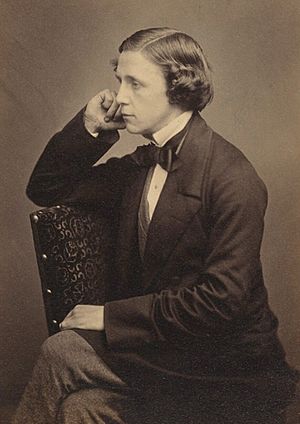Stuttering facts for kids

Stuttering (also called stammering) is when someone has trouble speaking smoothly. Their words might come out "bumpy" or not flow easily. People who stutter know exactly what they want to say, but sometimes their speech gets stuck or repeats.
About 5 to 6 out of every 100 children might stutter. For adults, it's about 1 out of 100. Boys are more likely to stutter than girls. Stuttering often starts when kids are between 2 and 6 years old and can sometimes run in families.
When someone stutters, you might notice things like:
- Repeating sounds: Like "b-b-ball" instead of "ball."
- Repeating parts of words: Like "ba-ba-banana."
- Blocks: When a person tries to say a word, but no sound comes out for a moment.
- Prolonging sounds: Stretching out a sound, like "ssssss-nake."
- Pauses: Stopping in the middle of a sentence.
- Rephrasing: Changing what they were going to say.
- Hesitations: Struggling to get words out.
- Fillers: Using phrases like "you know" to fill gaps.
- Tension: Their face or neck muscles might look tight.
- Body movements: Sometimes, people might blink or move their head when they stutter.
Contents
Feelings About Stuttering
Stuttering can be tough and make a person feel less confident. Imagine it like an iceberg. The parts of stuttering you can hear are like the tip of the iceberg above the water. But below the surface, there's a much bigger part: how the person feels.
People who stutter might feel embarrassed, ashamed, frustrated, scared, angry, or guilty. These feelings can make them more stressed, which sometimes makes their stuttering worse. Dealing with these feelings is an important part of getting help for stuttering.
Stuttering can affect people's lives. They might not feel confident enough to try for a job interview or make new friends.
Getting Help for Stuttering
There are different ways to help people who stutter speak more easily. This is often called stuttering therapy.
Fluency Shaping Therapy
This type of therapy helps people learn to speak more smoothly. It's sometimes called "speak more fluently" or "prolonged speech." In this therapy, people learn to control their breathing, lips, jaw, and tongue.
They practice slowing down their speech by stretching out sounds. This helps them speak very slowly without stuttering. Then, they gradually speed up their speech so it sounds more natural for everyday life. Some people find their speech sounds a bit different after this therapy.
Fluency shaping is often taught in group classes that might last a few weeks. Newer programs, like the Camperdown program, are shorter but still work well.
Stuttering Modification Therapy
The goal of this therapy is not to stop stuttering completely. Instead, it helps people change their stuttering so it's easier and less stressful. When people feel less scared or worried about stuttering, it can happen less often.
A well-known approach was created by Charles Van Riper in 1973. It has four main steps:
- Step 1: Identification
* The person who stutters and their speech and language therapist work together. They figure out exactly what the stuttering looks and feels like.
- Step 2: Desensitization
* In this step, the person works to feel less scared and worried about stuttering. They might practice "freezing" their stuttering or purposely stuttering. This helps them face difficult sounds or situations.
- Step 3: Modification
* Here, the person learns "easy stuttering." This means they learn ways to get out of a stutter more smoothly. * One way is "cancellations": stopping after a stutter, waiting a moment, and then saying the word again more easily. * Another is "pull-outs": smoothly moving out of a stutter into normal speech. * "Preparatory sets" mean looking ahead for words they might stutter on and getting ready to use "easy stuttering" on those words.
- Step 4: Stabilization
* In the final step, the person practices these new skills. They make "pull-outs" and "preparatory sets" automatic. They also start to see themselves as a person who speaks well, even if they sometimes stutter a little.
Famous People Who Stutter
Many famous people throughout history have stuttered:
- Demosthenes
- Isaac Newton
- Gareth Gates
- Notker Balbulus
- Scatman John
- Winston Churchill
- King George VI
- Bruce Willis
- Ozzy Osbourne
- Tiger Woods
See also
 In Spanish: Tartamudez para niños
In Spanish: Tartamudez para niños


